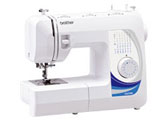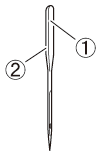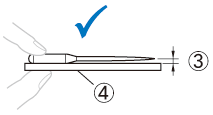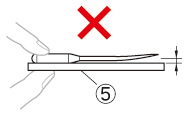GS2700
FAQs & Troubleshooting |

GS2700
Date: 21.10.2015 ID: faqh00000004_000
Combination of fabric, thread and needle
 Fabric / Thread / Needle Combinations
Fabric / Thread / Needle Combinations
The sewing machine needle is probably the most important part of the sewing machine.
Choosing the proper needle for your sewing project will result in a beautiful finish and fewer problems.
Below are some things to keep in mind about needles.
- The smaller the needle number, the finer the needle. As the numbers increase, the needles get thicker.
- Use fine needles with lightweight fabrics, and thicker needles with heavyweight fabrics.
- To avoid skipped stitches, use ball point needle (golden colored) 90/14 with stretch fabrics.
- To avoid skipped stitches, use ball point needle (golden colored) 90/14 when sewing character or decorative stitches.
- Use needle 75/11 for embroidery.
- It is recommended that a 90/14 needle should be used when embroidering on heavyweight fabrics or stabilizing products (for example, denim, puffy foam, etc.). A 75/11 needle may bend or break, which could result in injury.
- Ball point needles (golden colored) 90/14 are not recommended for embroidery, as they may bend or break, causing injury.
- Only use sewing machine needles for home use. Other needles may bend or break and cause injury.
- Never sew with a bent needle. A bent needle will easily break and cause injury.
Sewing with a bent needle is extremely dangerous since the needle may break while the machine is being operated.
Before using the needle, place the flat side of the needle on a flat surface and check that the distance between the needle and the flat surface is even.

(1) Flat side (2) Needle type marking
- Correct needle

(3) Parallel space (4) Flat surface
- Incorrect needle
If the distance between the needle and the flat surface is not even, the needle is bent.
Do not use a bent needle.

(5) Flat surface
The sewing machine needle that should be used depends on the fabric and thread thickness.
Refer to the following table when choosing the thread and needle appropriate for the fabric that you wish to sew.
| Fabric Type/Application | Thread | Size of Needle | ||
|---|---|---|---|---|
| Type | Size | |||
| Medium weight fabrics | Broadcloth | Cotton thread | 60 – 90 | 75/11 – 90/14 |
| Taffeta | Synthetic thread | |||
| Flannel, Gabardine |
Silk thread | 50 | ||
| Thin fabrics | Lawn | Cotton thread | 60 – 90 | 65/9 – 75/11 |
| Georgette | Synthetic thread | |||
| Challis, Satin |
Silk thread | 50 | ||
| Thick fabrics | Denim | Cotton thread | 30 | 100/16 |
| 50 | 90/14 – 100/16 | |||
| Corduroy | Synthetic thread | 50 – 60 | ||
| Tweed | Silk thread | |||
| Stretch fabrics | Jersey | Thread for knits | 50 – 60 | Ball point needle 75/11 – 90/14 (gold colored) |
| Tricot | ||||
| Easily frayed fabrics | Cotton thread | 50 – 90 | 65/9 – 90/14 | |
| Synthetic thread | ||||
| Silk thread | 50 | |||
| For top-stitching | Synthetic thread, Silk thread |
30 | 100/16 | |
| 50 – 60 | 75/11 – 90/14 | |||
Be sure to follow the needle, thread, and fabric combinations listed in the table. Using an improper combination, especially a heavyweight fabric (i.e., denim) with a small needle (i.e., 65/9 - 75/11), may cause the needle to bend or break, and lead to injury. Also, the seam may be uneven, the fabric may pucker, or the machine may skip stitches.
Never use a thread of weight 20 or lower. It may cause malfunctions.
Thread and needle number
The smaller the thread number, the thicker the thread; and the larger the needle number, the thicker the needle.
Ball point needle (gold colored)
Use the ball point needle when sewing on stretch fabrics or fabrics where skipped stitches easily occur.
Transparent nylon thread
Use a 90/14 to 100/16 needle, regardless of the fabric or thread.
BC-2500, BM-3500/2600, DS-140, FS155, FS70, GS2700, GS2786K, GS3700, GS3786K, Innov-is 10, Innov-is 1000, Innov-is 1250, Innov-is 1250D, Innov-is 1500D/1500, Innov-is 30, Innov-is 4000D/4000, Innov-is 50, Innov-is 900, Innov-is 950, Innov-is 980D, Innov-is 980K, Innov-is 985D, Innov-is I / Innov-is 6000D, Innov-is Ie, Innov-is V7, Innov-is VQ2, JA1450NT, JK17B, JS1750, NX-200/200QE, NX-250, NX-400Q/400, NX-450, XL-2120/2220/2230/2240
If you need further assistance, please contact Brother customer service:
Content Feedback
Please note this form is used for feedback only.




